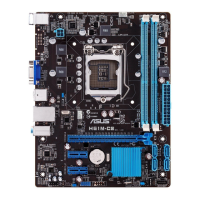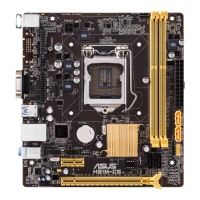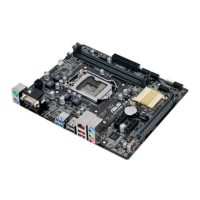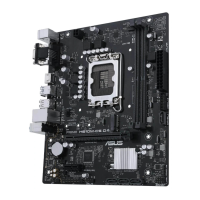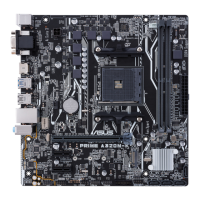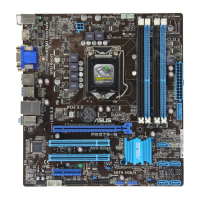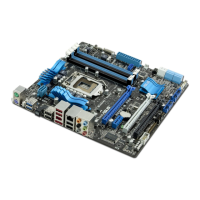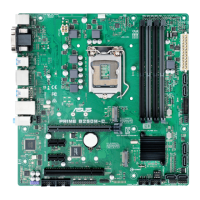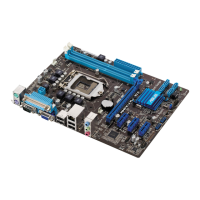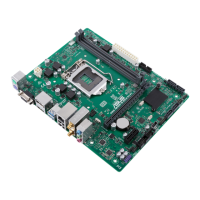Do you have a question about the Asus CS-B and is the answer not in the manual?
| Memory channels | Dual-channel |
|---|---|
| Memory slots type | DIMM |
| Number of memory slots | 4 |
| Supported memory types | DDR3-SDRAM |
| Maximum internal memory | 32 GB |
| Supported memory clock speeds | 1066, 1333, 1600 MHz |
| Processor socket | LGA 1150 (Socket H3) |
| Processor manufacturer | Intel |
| Compatible processor series | Intel Celeron, Intel Pentium |
| Intel® Core i3/i5/i7/i9 series | i3-4xxx, i5-4xxx, i7-4xxx |
| CPU fan connector | Yes |
| USB 2.0 connectors | 2 |
| Number of SATA connectors | - |
| Number of SATA III connectors | 5 |
| Number of Parallel ATA connectors | 0 |
| USB 3.2 Gen 1 (3.1 Gen 1) connectors | 1 |
| USB 2.0 ports quantity | USB 2.0 ports have a data transmission speed of 480 Mbps, and are backwards compatible with USB 1.1 ports. You can connect all kinds of peripheral devices to them. |
| Audio chip | Realtek ALC887-VD |
| Cooling type | Passive |
| Component for | PC |
| Power source type | ATX |
| Motherboard chipset | Intel® Q87 |
| Audio output channels | 7.1 channels |
| Motherboard form factor | micro ATX |
| RAID levels | 0, 1, 5, 10 |
| Supported storage drive interfaces | SATA III |
| Maximum resolution | 4096 x 2160 pixels |
| Number of displays supported | 3 |
| Cables included | SATA |
| LAN controller | Realtek RTL8111G |
| Ethernet interface type | Gigabit Ethernet |
| BIOS type | UEFI AMI |
| ACPI version | 2.0a |
| BIOS memory size | 16 Mbit |
| Width | 244 mm |
|---|
Essential safety guidelines for handling and operating the motherboard.
Explains the guide's organization and where to find more information.
Lists resources for updates and explains typography used in the manual.
Important safety and preparation steps before installation.
Introduces the motherboard and its physical orientation.
Visual representation of the motherboard's layout.
Detailed list of motherboard components and connectors.
Information on the CPU socket and supported processors.
How to install DDR3 DIMM modules and memory configurations.
Step-by-step instructions for CPU installation.
Guidance on attaching the CPU cooler assembly.
Details on memory configurations and compatibility.
Step-by-step procedures for handling DIMM modules.
Procedures for adding expansion cards to the motherboard.
Procedure to reset CMOS settings using the CLRTC jumper.
How to enable or disable the Intel ME function via jumper.
Details of each port on the rear I/O panel.
Descriptions of audio jacks and their channel configurations.
Details on LAN ports and USB connectivity options.
Descriptions of specific rear panel ports.
How to connect serial port modules internally.
Information on connecting the power supply unit.
How to connect the system's internal speaker.
Connecting front panel audio modules to the motherboard.
Connecting chassis intrusion detection sensors or switches.
Connecting case and CPU fans to motherboard headers.
Connecting SATA storage devices to the motherboard.
Connecting USB 3.0 front panel modules.
Connecting USB 2.0 front panel modules.
Connecting chassis front panel buttons and LEDs.
Connecting parallel port devices like printers.
Description and function of the standby power indicator LED.
Guidance on OS installation and using the support DVD.
Overview of BIOS management and update utilities.
Using ASUS EZ Update for software and BIOS updates.
Instructions for updating BIOS using the EZ Flash 2 utility.
Auto-recovery tool for corrupted BIOS files.
Procedures for updating BIOS using the DOS environment.
Methods to access the BIOS setup utility from startup or after POST.
Introduction to EZ Mode and Advanced Mode.
Explains the features of EZ Mode and how to access Advanced Mode.
Detailed description of the Advanced Mode interface elements.
Description of main menu categories and navigation controls.
How to save and manage favorite BIOS settings.
Steps to add frequently used BIOS items to My Favorites.
System information and basic settings like language, date, and time.
How to set, change, or clear administrator BIOS passwords.
How to set, change, or clear user BIOS passwords.
Introduction to the overclocking configuration settings.
Details on CPU Core Ratio, Cache Ratio, and BCLK Frequency.
Settings for memory operating frequency and integrated graphics boost.
Detailed configuration of primary and secondary DRAM timings.
Adjusting CPU voltage based on load conditions.
Settings for Intel SpeedStep, Turbo Mode, and CPU C-states.
Configuring CPU core voltage and offset modes.
Configuring CPU cache voltage and related parameters.
Configuration options for the Trusted Platform Module.
Settings for CPU cores, virtualization, and hardware prefetcher.
EIST, Turbo Mode, and CPU C-state configuration.
Specific settings for enhanced C1, C3, C6, C7 states and latency.
DMI Link control, ASPM support, and PCIe speed settings.
Settings for Intel Rapid Start Technology and hybrid disk support.
Configuration modes for SATA storage devices.
Settings for Intel Smart Connect Technology and deep sleep power policies.
Settings for graphics display, DMI, and PCIe Express.
Memory scrambler and memory remapping options.
Settings for Intel Active Management Technology.
Configuration for USB devices and xHCI controller mode.
Individual USB port control and platform miscellaneous configurations.
Configuration for remote serial port management.
Configuring onboard audio and Realtek/Intel LAN controllers.
Enabling/disabling PXE boot options for LAN controllers.
Settings for serial communication ports.
Settings for parallel communication ports.
Configuration for AC power loss recovery and wake-on events.
UEFI network stack settings and PXE boot support.
Monitoring CPU temperature and fan RPMs.
Monitoring critical CPU voltages.
Enabling and configuring CPU fan speed control features.
CPU fan speed profiles and low limit settings.
Chassis fan speed profiles and low limit settings.
Introduction to system boot options.
Settings to accelerate the system boot process.
Configuring USB and PS/2 device support during boot.
Controlling boot logo display and POST delay settings.
Settings for error reporting and third-party ROM messages.
Selecting BIOS setup mode and configuring CSM.
Controlling boot device order and secure boot features.
Managing secure boot keys for system security.
Managing the Platform Key for firmware security.
Managing the Key Exchange Key for signature databases.
Managing the authorized signature database.
Managing the revoked signature database.
Setting boot device sequence and overriding default boot order.
Running the ASUS EZ Flash 2 utility for BIOS updates.
Saving and loading overclocking profiles.
Viewing Serial Presence Detect information for DIMMs.
Loading default BIOS settings.
Exiting BIOS and saving or discarding changes.
Switching to EZ Mode from the Exit menu.
Regulatory compliance statements for FCC and Industry Canada.
Japanese, Korean, and EU chemical substance compliance.
Information on responsible disposal and recycling of the product.
General contact and technical support information for ASUS offices worldwide.
Official FCC compliance declaration for the motherboard.
Official European Community conformity declaration for the motherboard.
